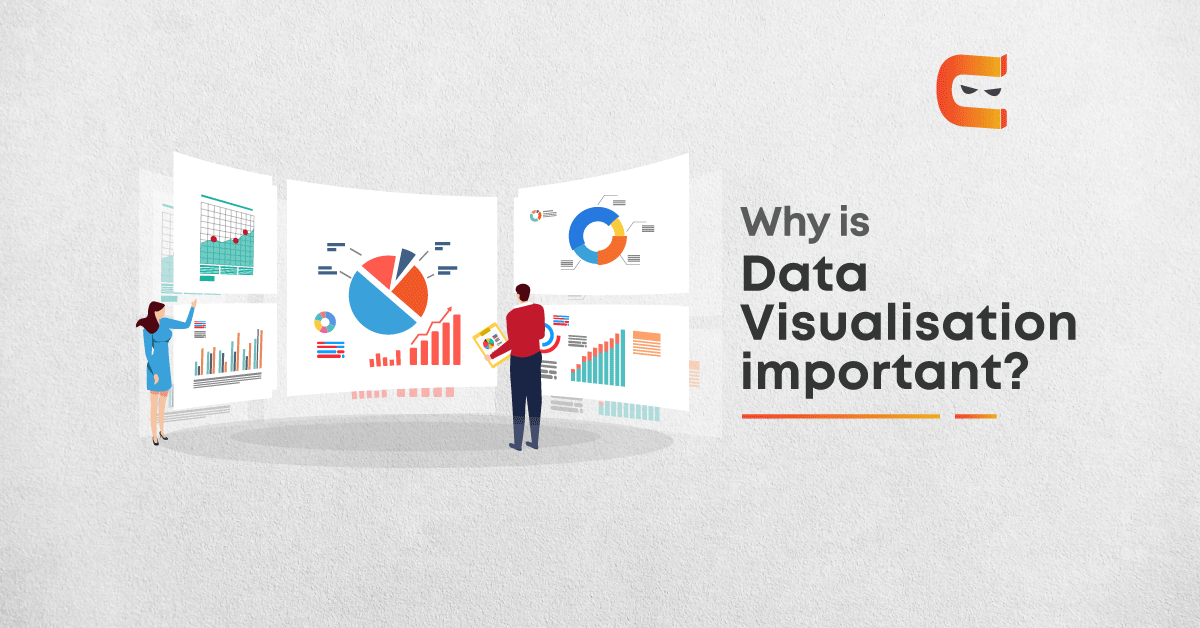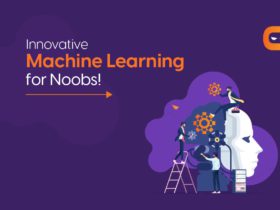Table of Contents
Introduction
Data is said to be increasing manifoldly with each passing minute. And this has given a boost to careers in Data Science, Data Analytics and, other data operating-related fields. And with this, it becomes extremely important to visualize whatever we are processing.
So if you are interested in making a career in Data Science, or if you have ever heard about Data Analysis, then Data Visualization is something you should not miss.
What is Data Visualization?
Data Visualization is the representation of any relevant data or information in visual formats. These formats could be charts, graphs, maps, tables, and many more. It helps in presenting analytics visually, which eases decision-making by identifying complex concepts and patterns.
With Data Visualization, we can level up the analysis by using technology to closely examine the charts and graphs and process for further information. Data Visualization can also be used in other domains such as finance, technology, marketing, designing or, any other area where there is a need to visualize the data.
Need for Data Visualization
Let us talk about few technologies that incorporate data processing. Talking about Data Science, the field encompasses the processes of extraction, cleaning and, formulating data. And later, Machine Learning utilizes this refined data for training purposes.
You can check out Data Science and Machine Learning courses at our website However, Data Analytics is a field that helps analysts to typically analyze and process raw data using various tools and techniques and look for patterns, trends and, insights in the data. This eventually helps the organisations to make serious decisions.
But even after taking care of all these steps, if you fail to represent the outcome, all your pain goes in vain. Here is when Data Visualization comes into the picture.
History of Data Visualization
It dates back to as old as the 17th century. Where the expeditors like Napolean used pictures and maps to understand places and plan invasions and sailing paths. Later in the 1800s concepts of charts and analytical graphs were introduced. This today, forms the core of our statistics syllabus.
Why is Data Visualization important?
Data Visualization is important because the human brain finds a visual summary of data, by using charts or graphs to visualize large amounts of complex data much easier than rushing over spreadsheets and lengthy reports. It is a simple and faster way to convey concepts more comprehensively.
As our main objective is to gain insights, data becomes more precious when visualized. Even if the analysts summarize data findings without visualization, it would become hard to communicate their meaning without visualizing it. Thus graphs and charts make the communication of data insights and pattern findings, effortless with visualization.
How is Data Visualization used today?
1. Transition with time
Data Visualization helps to monitor the changing trends with time. They offer a better analysis of the varying data. The initial step of data analysis begins with the aggregation of raw and unprocessed data.
And it becomes important to keep a track of the frequency of relevant data and modifications coming in these raw datasets as a result of passing time.
This also helps in monitoring the gross profit and loss and performance of the company over time. Also, we can track opportunities that can act valuable or risky accordingly.
2. Show correlations
Visualization of data helps determine the relationship between two entities. It is one of the most useful ways to introspect the correlation in data items. It displays the interdependency of the data i.e whether the data entities are dependent or independent of each other.
3. Monitoring data network
In finance and marketing, establishing a connection with the target audience serves valuable. Finance analysts and marketing professionals need to identify their potential customers, outliers, influencers and, a link between them and clients. It can help to identify areas that need attention or requires improvement. And understand sales influencing factors and predict sales volumes.
Data Visualization Models
There are many automated and manual models used for visualizing the data. Let us look at some of the most widely used data visualization models and their usage.
- TEMPORAL: Visualizations that are linear and one-dimensional come under the temporal category. Temporal data visualizations exhibit lines that either stand-alone or are overlapping with each other, with start and finish time. Some of their examples include-: Line plots, Scatter plots, Time series sequences, Polar area diagrams.
- GEOSPATIAL: Also known as spatial data visualizations corresponding to physical locations, overlaying familiar maps with dissimilar data points. They are commonly used to display sales or acquisitions over a certain period. They are used to plan political campaigns or to display market penetration in multinational corporations. Some of their examples are-: Cartograms, Density map, Flow map, Heat Maps.
- HIERARCHIAL: They are suitable to show hierarchy within different data clusters and show the parent-child relationship. They grow downwards in the form of tree branches and become quite complex to understand as they branch more. Some of their examples are-: Tree Diagrams, Ring Charts, Sunburst Diagrams, Frame Diagrams.
- MULTI-DIMENSIONAL: This is a 3D data visualization model. In this, more than two variables are used for analysis and, due to its different layers of representation, it is quite eye-catchy. Some of their examples are-: Scatter Plots, Venn Diagrams, Histograms, Bar Charts.
- NETWORK: This shows relationships and linking of data entities within networks as well as with other networks. Some of their examples are-: Node-link Diagrams, Matrix Charts, Word Clouds, Alluvial Diagrams.
Data Visualization Tools
Data Visualization helps us to understand the underlying data patterns during data analytics. Here is a list of the top five most popular data visualization tools.
- TABLEAU: It is quite popular and most widely by scientists and data analysts as it processes huge data sets within a short interval of time and provides the highest level of security and protection from data thefts. Analysts use Tableau to prepare, clean and, format their data and then represent data in suitable visualizations. Tableau offers a 14-day free trial followed by a paid version.
- SISENSE: It is a Business Intelligence-based data visualization software that provides various tools to process complex data and obtain insights. Analysts can easily export their files in different formats such as PDF, PPT, MS Word/Excel, etc. SIENSE can be easily downloaded and installed.
- IBM COGNO ANALYTICS: It is an Artificial Intelligence-based Business Intelligence tool. You can analyze and visualize the data at the same time. Those who want to begin their career in Data Analytics can use this tool as it is easy to use. It offers cloud support for file sharing. Data sets can be imported from sources such as CSV files, cloud, spreadsheets, etc. It offers a 30-day free trial plan.
- QLIK SENSE: It helps organisations to become data-driven by providing an associated data analytics engine, sophisticated AI system and, scalable multi-cloud architecture. You can easily load, visualize and explore big data by using drag and drop. Quik Sense offers a free 30-day trial.
- MICROSOFT POWER BI: It is a Data Visualization platform focused on creating a data-driven business intelligence culture in organizations. It offers services to analyze, aggregate and represent and share data in a meaningful manner. It goes easy on the pocket and offers extensive customer support.
Frequently Asked Questions
Yes, data visualization forms a part of machine learning. The main goal of machine learning engineers is to provide clear data insights and build accurate machine learning models. And for this, multiple steps are required.
Out of which, the two most prominent ones are data pre-processing( Cleaning, Formatting, Scaling, Normalization) and visualization of data in various formats.
Data Visualization is a technique to represent relevant pieces of information and summarize processed data results in visual formats such as graphs, charts, plots and, many more. Thus making the analysis of data easier to understand.
Data serves as food for Artificial Intelligence as it helps the intelligence bots to learn the aspects of human intelligence and their responsive behavior. However, AI cannot stand for itself when asked to produce a relative analysis of the data that it needs and from where and how it derives them.
That’s where we need data visualization to show the infographics and statistical reports of the data consumed by the bots and how it has utilized them. Data Visualization can also be used to show the apt data on finances that were done during the production of bots.
Data Analytics deals with the numerous methods of examining the data and administering them for various purposes. Data visualization deals with the visual summarization of the outcomes which comes as a result of the operations done on the data sets. A visual representation of data adds more meaning to the data and gets communicated more easily and efficiently.
Key Takeaways
Now, you must be able to figure out why visualization of data is important. When you are working on Machine Learning models, it becomes important to analyze the data before loading it into supervised and unsupervised ML algorithms.
Talking about Data Science, once you have learned how to work upon different file formats using Pandas and Numpy, you need to learn how to visualise data by plotting different graphs using Matplotlib. You can check out our Machine Learning and Data Science course to gain more insights on this topic by logging to our website.
By Shivi Srivastava















Leave a Reply